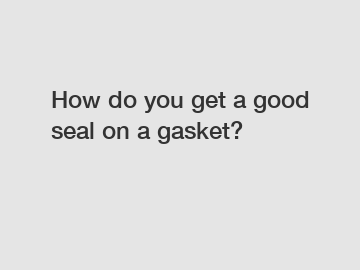Jan. 13, 2024
Mechanical Parts & Fabrication Services
Goto JiZan to know more.
How to Achieve a Proper Seal on a Gasket.
Gaskets play a crucial role in ensuring a tight and leak-free seal in various mechanical systems. However, achieving a proper seal requires attention to detail and careful installation. In this article, we will discuss the steps you can take to ensure a good seal on a gasket, from selecting the right gasket material to proper installation techniques.

Choosing the Right Gasket Material.
Selecting the appropriate gasket material for your specific application is essential to achieving a good seal. Gaskets are made from a variety of materials, including rubber, silicone, cork, and metal. Each material has its own unique properties, such as resistance to heat, chemicals, and pressure. It is important to consider the temperature, pressure, and compatibility with the fluids or gases your system will be handling. Consulting with a gasket manufacturer or supplier can help you determine the best material for your specific needs.
Preparing the Surfaces.
Proper surface preparation is crucial for achieving a good seal. Before installing a gasket, it is important to clean and inspect the mating surfaces. Any dirt, debris, or old gasket material should be thoroughly removed using a suitable solvent or scraping tool. Ensure that the mating surfaces are smooth, flat, and free of any imperfections that could prevent a proper seal.
Applying the Gasket.
Once the surfaces are properly prepared, the next step is to carefully apply the gasket. Begin by ensuring that the gasket is the correct size and shape for the flange or fitting it will be sealing. Gaskets are often supplied in standard sizes, but they can also be custom-made to fit specific dimensions.
Ensure that the gasket is correctly positioned on the mating surface, aligning any bolt holes or alignment marks. Applying a thin coat of gasket sealant or adhesive can help improve the seal, especially in applications that involve high temperatures or pressure. However, it is important to follow the manufacturer's instructions and use the appropriate type and amount of sealant.
Tightening the Bolts.
Once the gasket is properly positioned, it is time to tighten the bolts or fasteners to achieve the desired compression. It is important to follow the recommended torque specifications provided by the gasket manufacturer to prevent over-tightening or under-tightening. Tightening the bolts evenly and in a cross-pattern can help distribute the compression evenly across the gasket, minimizing the risk of leaks.
Performing a Leak Test.
After the gasket is installed and the bolts are properly tightened, it is recommended to perform a leak test to ensure the seal is effective. This can be done by pressurizing the system or applying soapy water around the gasket and looking for any bubbles that may indicate a leak. If a leak is detected, it may be necessary to reevaluate the gasket or the installation process to address the issue.
In summary, achieving a good seal on a gasket involves selecting the right material, properly preparing the surfaces, applying the gasket correctly, and tightening the bolts to the recommended specifications. Following these steps will help ensure a leak-free and efficient system. For more information or assistance, please do not hesitate to contact us.
For more information, please visit epdm sponge strip manufacturer.
If you are interested in sending in a Guest Blogger Submission,welcome to write for us!
All Comments ( 0 )